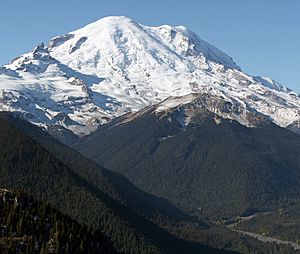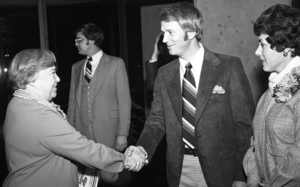Dixy Lee Ray facts for kids
Quick facts for kids
Dixy Lee Ray
|
|
|---|---|
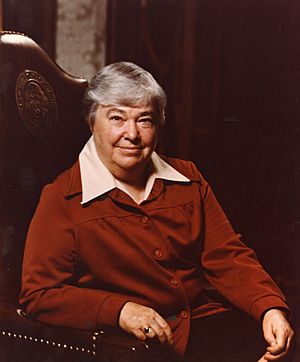 |
|
| 17th Governor of Washington | |
| In office January 12, 1977 – January 14, 1981 |
|
| Lieutenant | John Cherberg |
| Preceded by | Daniel J. Evans |
| Succeeded by | John Spellman |
| Assistant Secretary of State for Oceans and International Environmental and Scientific Affairs | |
| In office January 19, 1975 – June 20, 1975 |
|
| President | Gerald Ford |
| Preceded by | Position established |
| Succeeded by | Frederick Irving |
| Chair of the Atomic Energy Commission | |
| In office February 6, 1973 – January 18, 1975 |
|
| President | Richard Nixon Gerald Ford |
| Preceded by | James Schlesinger |
| Succeeded by | Position abolished |
| Personal details | |
| Born |
Marguerite Ray
September 3, 1914 Tacoma, Washington, U.S. |
| Died | January 2, 1994 (aged 79) Fox Island, Washington, U.S. |
| Political party | Democratic |
| Education | Mills College (BS, MS) Stanford University (PhD) |
| Signature | |
Dixy Lee Ray (born September 3, 1914 – died January 2, 1994) was an American politician and scientist. She made history as the 17th governor of Washington from 1977 to 1981. She was the first woman to hold this important position in Washington state. During her time as governor, the famous 1980 eruption of Mount St. Helens happened. Dixy Lee Ray was also a strong supporter of atomic energy.
Ray studied at Mills College and Stanford University, where she earned a high degree in biology. In 1957, she became a professor at the University of Washington. She even worked as a chief scientist on a research ship called the SS Te Vega. She also helped turn the Pacific Science Center into a fun, interactive learning place, saving it from financial trouble.
In 1973, President Richard Nixon chose Ray to lead the United States Atomic Energy Commission (AEC). This group was in charge of atomic energy research. Later, in 1975, President Gerald Ford appointed her to a role in the State Department. However, she resigned after only six months because she felt she didn't have enough say in decisions.
In 1976, Dixy Lee Ray decided to run for Governor of Washington as a Democrat. She won the election, even though she was known for being very direct and sometimes challenging. As governor, she supported using supertankers in Puget Sound and encouraged growth and development. She also continued to be very enthusiastic about atomic energy. On April 3, 1980, she declared a state of emergency because of the volcanic eruption of Mount St. Helens. She left office after losing her bid for re-election later that year.
Contents
Early Life and Education
Dixy Lee Ray was born Marguerite Ray in Tacoma, Washington. She was the second of five girls in her family. When she was 12, she became the youngest girl at that time to climb to the top of Mount Rainier. In 1930, at age 16, she officially changed her name to "Dixy Lee." She chose "Dixy" from a childhood nickname and "Lee" because of a family connection to Robert E. Lee.
Ray went to Stadium High School in Tacoma. She then graduated at the top of her class from Mills College in Oakland, California, in 1937. She worked as a waitress and janitor to pay for her schooling. She earned her master's degree in 1938. For the next four years, she taught science in Oakland. In 1942, she began studying for her doctorate degree in biology at Stanford University. She finished her research in 1945 at the Hopkins Marine Station in Pacific Grove.
Scientific Career
University of Washington
In 1945, Ray returned to Washington state. She became an instructor in the zoology department at the University of Washington. She was promoted to assistant professor in 1947. Five years later, she received a special grant that allowed her to do more research at Caltech. In 1957, she became an associate professor at the University of Washington. During her time there, she also worked as a chief scientist on the schooner SS Te Vega for a big ocean exploration trip.
KCTS-TV and Pacific Science Center
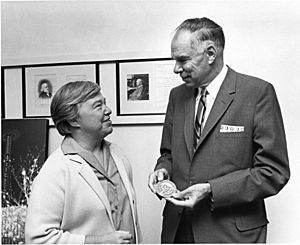
People at KCTS-TV, Seattle's public television station, thought Dixy Lee Ray could make science exciting. They asked her to host a weekly show about marine biology called Animals of the Seashore. The show was very popular and made her well-known. Because of her growing fame, the Pacific Science Center asked her to take over. The museum was almost out of money. Ray quickly started to change the center. She wanted it to be an interactive learning place, not just a museum with old exhibits. Under her leadership, the Pacific Science Center became financially stable again. Her efforts also helped her meet many important people in the city.
Government Roles
Atomic Energy Commission
Dixy Lee Ray was a strong supporter of nuclear power. In 1973, Richard Nixon appointed her to lead the United States Atomic Energy Commission (AEC). This commission was responsible for atomic energy in the U.S. She was initially hesitant to take the job because it meant moving to Washington, D.C. However, her friend Lou Guzzo convinced her.
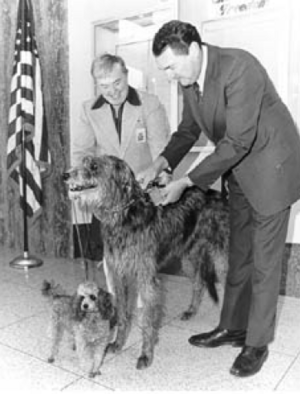
After she took the job, people noticed her unique personal style. She lived in a 28-foot motor home parked in rural Virginia. Every morning, she was driven to her office with her large Scottish deerhound dog, Ghillie, and a small miniature poodle named Jacques. She was also known for wearing white knee socks.
Less than a year after she started, Ray made big changes at the AEC. She ordered that research and development be kept separate from safety programs. The AEC was also in charge of making nuclear weapons. Ray once said that seeing a nuclear warhead was "like a piece of beautiful sculpture." She led the commission until it was closed in 1975.
U.S. State Department
In 1975, Gerald Ford appointed Ray as Assistant Secretary of State for Oceans and International Environmental and Scientific Affairs. She resigned five months later. She felt she didn't have enough say in the department's decisions. She later told a committee that she only met Secretary of State Henry Kissinger once. As she left Washington, D.C., Ray said that "anything the private sector can do, the government can do it worse."
Governor of Washington (1977–1981)
Campaign and Election
In 1975, Dixy Lee Ray surprised many people by announcing she would run for Governor of Washington. When asked why she chose the state's highest office for her first political campaign, she said she was "much too old to start at the bottom." She decided to run as a Democrat.
Ray was known for her direct and sometimes challenging style during her campaign. She won the Democratic nomination even though she spent very little money. She had no previous experience running for elected office. She also had little support from the state's political leaders. Despite opposition from major newspapers, Ray won the general election in 1976. She defeated King County Executive John D. Spellman with 53% of the votes. When a reporter asked her to explain her surprising victory, she joked, "it can't be because I'm so pretty?"
Leading the State
After becoming governor, Ray worked to control state spending. She also started checking state salaries and programs. She balanced the state budget. During her time as governor, the state fully funded basic public education for the first time. Since she was the first governor without a First Lady, Ray hired her older sister, Marion R. Reid, to be her official hostess.
However, she quickly upset other Democrats because of her conservative views on energy and the environment. She allowed supertankers to dock in Puget Sound. She also strongly supported growth and development and continued to promote atomic power. She also upset Republicans when she fired 124 people who had been appointed by the previous governor. She replaced them with people she knew. Her interactions with the media were also often dismissive.
Rays strong belief in her own ideas sometimes caused disagreements with other governors. For example, she disagreed with the Oregon governor about energy conservation. She believed Washington's voluntary programs were enough.
Press and political opposition grew because of her firm way of governing. Ralph Nader once called her administration "gubernatorial lunacy." Even her own campaign manager said, "we thought she would be the best governor Washington ever had, or the worst, and we were right." However, many scientists supported her.

Mount St. Helens Eruption
On April 3, 1980, Ray declared a state of emergency because of the growing threat from Mount St. Helens. She warned that a "major eruption or mudflow is real." She urged people to stay away from the mountain, even though some were doubtful.

On April 30, she declared a "red zone" where public access was forbidden. People in this area would have to move if needed. Ray ordered the Washington National Guard and Washington State Patrol to help enforce this. Violating the ban could lead to six months in prison. The U.S. Forest Service later said these restrictions saved thousands of lives. However, Ray was criticized for also creating a "blue zone." The public was banned there, but loggers from a company called Weyerhaeuser were allowed. When the mountain erupted, 11 loggers in the blue zone were killed.
As a scientist, Ray was very interested in the possibility of an eruption. In the weeks before the event, she flew over the mountain in the governor's plane. She said, "I've always said I wanted to live long enough to see one of our volcanoes erupt." The huge eruption happened on May 18, 1980, and killed 57 people. The ash cloud, earthquakes, and floods caused massive destruction. The next day, Ray used her emergency powers to postpone local elections.
Ray ran for re-election in 1980 but lost in the Democratic primary election.
Later Life and Death
After Politics
After leaving office, Dixy Lee Ray moved back to her farm on Fox Island. She often shared her opinions on current events. She co-wrote two books with Lou Guzzo that were critical of the environmentalist movement. In one book, she described environmentalists as mostly "white, middle to upper income" people with a "do-good mentality."
Death and Legacy
Dixy Lee Ray died on January 2, 1994, at her home. She had suffered from a bronchial infection that led to pneumonia.
Many people shared their thoughts on her life after her death. Her successor as governor, John Spellman, called her "one of a kind." He said she had a "brilliant mind" and a "bubbling personality." He noted that people weren't used to someone so outspoken, but they still liked her.
Her friend and co-author, Lou Guzzo, thought she "should have never gone into politics." He said, "We thought it was time for someone in politics who tells the truth all the time. It didn't work."
In 2014, journalist Knute Berger wrote that Ray was ahead of her time. He said many of her views are now more accepted.
After her death, the American Society of Mechanical Engineers (ASME) created an award in her honor. This award recognizes engineering contributions to environmental protection.
Ray's papers, including 190 boxes of records and items from her career, are kept at the Hoover Institution Library and Archives at Stanford University.
Honors
- 1958: Clapp Award in Marine Biology
- 1973: Frances K. Hutchinson Medal for Service in Conservation
- 1973: United Nations Peace Medal
- 1974: Francis Boyer Science Award
- 1979: Golden Plate Award of the American Academy of Achievement presented by Awards Council member Edward Teller at the Achievement Summit in Salt Lake City, Utah
Ray also received twenty honorary doctorates from universities in the U.S. and other countries.
Images for kids
See also


